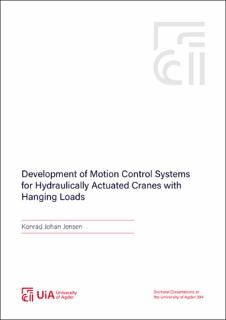| dc.contributor.author | Jensen, Konrad Johan | |
| dc.date.accessioned | 2023-01-18T09:45:50Z | |
| dc.date.available | 2023-01-18T09:45:50Z | |
| dc.date.created | 2023-01-16T20:14:32Z | |
| dc.date.issued | 2023 | |
| dc.identifier.citation | Jensen, K. J. (2023). Development of Motion Control Systems for Hydraulically Actuated Cranes with Hanging Loads [Doctoral dissertation]. University of Agder. | en_US |
| dc.identifier.isbn | 978-82-8427-107-1 | |
| dc.identifier.issn | 1504-9272 | |
| dc.identifier.uri | https://hdl.handle.net/11250/3044214 | |
| dc.description.abstract | Automation has been used in industrial processes for several decades to increase efficiency and safety. Tasks that are either dull, dangerous, or dirty can often be performed by machines in a reliable manner. This may provide a reduced risk to human life, and will typically give a lower economic cost. Industrial robots are a prime example of this, and have seen extensive use in the automotive industry and manufacturing plants. While these machines have been employed in a wide variety of industries, heavy duty lifting and handling equipment such as hydraulic cranes have typically been manually operated. This provides an opportunity to investigate and develop control systems to push lifting equipment towards the same level of automation found in the aforementioned industries. The use of winches and hanging loads on cranes give a set of challenges not typically found on robots, which requires careful consideration of both the safety aspect and precision of the pendulum-like motion. Another difference from industrial robots is the type of actuation systems used. While robots use electric motors, the cranes discussed in this thesis use hydraulic cylinders. As such, the dynamics of the machines and the control system designmay differ significantly. In addition, hydraulic cranes may experience significant deflection when lifting heavy loads, arising from both structural flexibility and the compressibility of the hydraulic fluid.
The work presented in this thesis focuses on motion control of hydraulically actuated cranes. Motion control is an important topic when developing automation systems, as moving from one position to another is a common requirement for automated lifting operations. A novel path controller operating in actuator space is developed, which takes advantage of the load-independent flow control valves typically found on hydraulically actuated cranes. By operating in actuator space the motion of each cylinder is inherently minimized. To counteract the pendulum-like motion of the hanging payload, a novel anti-swing controller is developed and experimentally verified. The anti-swing controller is able to suppress the motion from the hanging load to increase safety and precision. To tackle the challenges associated with the flexibility of the crane, a deflection compensator is developed and experimentally verified. The deflection compensator is able to counteract both the static deflection due to gravity and dynamic de ection due to motion. Further, the topic of adaptive feedforward control of pressure compensated cylinders has been investigated.
A novel adaptive differential controller has been developed and experimentally verified, which adapts to system uncertainties in both directions of motion. Finally, the use of electro-hydrostatic actuators for motion control of cranes has been investigated using numerical time domain simulations. A novel concept is proposed and investigated using simulations. | en_US |
| dc.language.iso | eng | en_US |
| dc.publisher | University of Agder | en_US |
| dc.relation.ispartofseries | Doctoral Dissertations at the University of Agder; no. 394 | |
| dc.relation.haspart | Paper I: Jensen, K. J., Ebbesen, M. K. & Hansen, M. R. (2020). Development of Point-to-Point Path Control in Actuator Space for Hydraulic Knuckle Boom Crane. Actuators, 9(2): 27. https://doi.org/10.3390/act9020027. Published version. Full-text is available in AURA as a separate file: https://hdl.handle.net/11250/2655773. | en_US |
| dc.relation.haspart | Paper II: Jensen, K. J., Ebbesen, M. K. & Hansen, M. R. (2020). Adaptive Feedforward Control of a Pressure Compensated Differential Cylinder. Applied Sciences, 10(21): 7847. https://doi.org/10.3390/app10217847. Published version. Full-text is available in AURA as a separate file: https://hdl.handle.net/11250/2711494. | en_US |
| dc.relation.haspart | Papper III: Jensen, K. J., Ebbesen, M. K. & Hansen, M. R. (2021). Anti-swing control of a hydraulic loader crane with a hanging load. Mechatronics, 77: 102599. https://doi.org/10.1016/j.mechatronics.2021.102599. Published version. Full-text is available in AURA as a separate file: https://hdl.handle.net/11250/2987575. | en_US |
| dc.relation.haspart | Paper IV: Jensen, K. J., Ebbesen, M. K. & Hansen, M. R. (2021). Novel Concept for Electro-Hydrostatic Actuators for Motion Control of Hydraulic Manipulators. Energies, 14(20): 6566. https://doi.org/10.3390/en14206566. Published version. Full-text is available in AURA as a separate file: https://hdl.handle.net/11250/2824470. | en_US |
| dc.relation.haspart | Paper V: Jensen, K. J., Ebbesen, M. K. & Hansen, M. R. (2021). Development of 3D anti-Swing control for hydraulic knuckle boom crane. Modeling, Identification and Control, 42(3), 113-129. http://dx.org/10.4173/mic.2021.3.2. Published version. Full-text is available in AURA as a separate file: https://hdl.handle.net/11250/2987869. | en_US |
| dc.relation.haspart | Paper VI: Jensen, K. J., Ebbesen, M. K. & Hansen, M. R. (2022). Online Deflection Compensation of a Flexible Hydraulic Loader Crane Using Neural Networks and Pressure Feedback. Robotics, 11(2): 34. https://doi.org/10.3390/robotics11020034. Published version. Full-text is available in AURA as a separate file: https://hdl.handle.net/11250/3044108. | en_US |
| dc.rights | Attribution-NonCommercial-NoDerivatives 4.0 Internasjonal | * |
| dc.rights.uri | http://creativecommons.org/licenses/by-nc-nd/4.0/deed.no | * |
| dc.title | Development of Motion Control Systems for Hydraulically Actuated Cranes with Hanging Loads | en_US |
| dc.type | Doctoral thesis | en_US |
| dc.description.version | publishedVersion | en_US |
| dc.rights.holder | © 2023 Konrad Johan Jensen | en_US |
| dc.subject.nsi | VDP::Teknologi: 500::Bygningsfag: 530 | en_US |
| dc.source.pagenumber | 234 | en_US |
| dc.source.issue | 394 | en_US |
| dc.identifier.cristin | 2108130 | |







